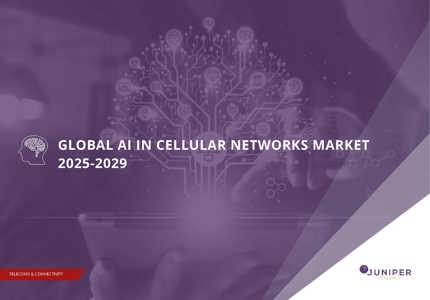How is AI Being Used Within Network Orchestration?
It is only in recent years that more awareness has been given to the potential impacts of AI on future network operations. Given that networks continuously innovate and rely more on software-defined functions, these impacts cannot be understated – and indeed, are key to realising the $20 billion spend by mobile network operators globally on AI-powered network orchestration by 2028.
As we discuss in our latest research, there are five key services that will generate AI spend from network operators:
- Network Performance
- Network Automation
- Network Security
- Predictive Maintenance
- Customer Support
Network Performance
AI has been significantly utilised for the optimisation of network performance. This has mostly come down to the evolution of the functionality of AI, as well as machine learning.
Early AI uses basic and static rules-based functionality which is simply there to relieve a human of consistent repetitive task. These involve AI with a level of programming in them that is highly pre-determined and will not deviate much as there is little expectation for the nature of these simple repetitive tasks to change. What is significant is that these more basic network orchestration tasks will be most likely in the majority of the full magnitude of work needed, and can help alleviate a significant bulk of the work that might otherwise be done by humans.
As far as network orchestration is concerned, it is RANs (Radio Access Networks) – which are the intermediary systems between the core of those networks and the edge connections – that are going to be of main interest for the implementation of AI solutions. This will primarily be via the augmentation or replacement of their algorithms and processes in order to improve performance and versatility.
Another prominent process in which network performance can be enhanced is with regard to traffic and bandwidth load management and balanced allocation. AI can be leveraged for analysing the intricacies of network traffic at a given time and making highly informed automated decisions for adjusted routing. This has a range of benefits including the avoidance of network outages and disruptions and overall increased customer satisfaction.
Network Automation
The use of AI and machine learning in network orchestration has massive transformative potential when it comes to automation in a wide variety of processes.
- Network Configuration - The processes involved in creating network settings, controls and policies. It is conducive to automation when network management is more virtual and software based.
- Analytics - Processes involving in the collection of network data in order to analyse it and drive insights towards improvements in network performance.
- Maintenance - Any processes involved in order to keep the network running smoothly. This primarily includes troubleshooting network issues, as well as configuration tasks, monitoring and analysis.
- Load Allocation - This is the best estimations of loading and distributing loads across a network to promote efficiency. This depends on the data available and the sophistication of the techniques of analysis.
- Security - All processes involved in protection of integrity, usability and confidentiality of a network, as well as the prevention of unauthorised access.
- Testing and Validation - This involves the processes for verifying the stability of a network, usually through simulated traffic. This is to identify potential network issues through actual trial and error.
- Customer Support - This is the processes of providing tailored support to individual customer queries and issues, as well as general measures to anticipate customer experience issues and prevent against them.
Network configuration is becoming increasingly more critical; given the highly dynamic and changeable state of network processes at the present time. AI-powered automation of these processes can be highly beneficial. Time is becoming scarcer for network operators to keep up to date with dynamic market trends, as well as highly changeable legal and regulatory environments. AI solutions in automation are becoming necessary for reducing time required for deployment, modification and scalability.
Network configuration is also where attention to detail, accuracy and consistency are quite necessary, and hence where human error leaves these actions vulnerable. The reduction or elimination of human error through AI solutions can be highly valuable for the avoidance of network misconfiguration; leading to disruption of security or legality risks.
Network Security
With increasing scalability and innovation in new dynamic market trends for network orchestration, this will come with immediate and important new security requirements in order for these changes to be most sustainable.
AI solutions are helpful for a wide range of security areas such as intelligent threat detection, incident response, policy enforcement, auditing, segmentation, access controls and investigation and forensics.
Threat detection involves the analysis of networks and their traffic and user behaviour in order to detect anomalies, deviations, phishing attacks, compromises and malware in a way that is more timely and hence cost-effective than less automated intelligent methods. On top of immediate detections, it can also be used for more measured analysis in network forensics.
In addition to issue detection, AI can be leveraged in response and resolution. There can be quick time-saving methods of severity assessment, execution of already pre determined actions, as well as the avoidance of human error. The programming that will go into AI solutions concerned with network security will be more likely to have pre-determined established processes than incorporating machine learning capabilities, as it is important for security protocols to be more established, regardless of whether they are adhered to via AI or not.
AI solutions can also be deployed for security reasons, to facilitate network segmentation and isolation when required for a given security issue. Segmentation and isolation are crucial for when a network is compromised, and the fault can be contained to prevent lateral movement but without the need for entire networks to be shut down. AI solutions in these processes can be highly beneficial for quick responses, action and notification.
Predictive Maintenance
The automation capabilities of AI solutions can be highly relevant to network maintenance. Not only can they free up the workloads and time of what general processes would otherwise be performed by humans, they can also reduce the time and resources lost that are involved in actually fixing network faults, which might otherwise be simply prevented.
Vulnerability testing is a significant part of predictive maintenance. AI can implement scanning for vulnerability in networks, which might include issues such as misconfigurations, software that has not been updated, security risks or incorrect user permissions. It can also automate analysis into the ranking and prioritisation of different vulnerabilities, based on attributes such potential impact or time constraints. On top of analysis and detection, the processes of patching and repair can be automated in order to reduce or eliminate time windows of vulnerability.
AI solutions can be significantly utilised for analytics of network processes. This can not only achieve a higher rate of data processing than a more voluntary human cantered approach, but can also be consistent and ongoing both within and outside of working hours. Not only are AI solutions conducive to the analysis of a large scale of network data, but can also notice intricate patterns and relationships that might otherwise be missed. This is significantly relevant in root-cause analysis when it comes to solving more complex network issues that require it in great detail.
Customer Support
A significant leveraging of AI is in automating processes in customer support.
On top of more general implementations of AI for the general improvement of customer experiences, AI can be more specifically used for customer support and services through the deployment of customer service interfaces and chatbots. Network operators looking to deal with the bulk and scale of customer queries (which might especially be the case given the general network scalability that new trends in AI usage can bring to network orchestration) in the most sustainable way, they might be looking to automate those processes with AI-powered chatbot solutions.
AI-based customer service can be deployed over a large range of channels and media to ensure the greatest convenience and adaptability to the customer’s needs; communicating with them on their preferred platform instead of making them adopt a brand-new messaging channel. These channel and platforms might be email, social media, SMS and voice.
On top of the ability to free up time for human workers, chatbots have the benefit of being able to automate the handling of the queries. There will always remain some customer queries that are complex enough to need a human agent to deal with them, but those queries are likely to always be in the small minority, implying that the benefits of AI-based customer support can be easily felt given its limitations.
AI-based customer service can also answer and resolve queries instantly. Human based customer service lacks this given its inevitable dependence on constrained agent availability and can significantly reduce or even completely eliminate waiting times.
Diagnosis of the queries can also be more efficient and precise if they can significantly limit the possibility of human error as well as analyse larger amounts of information concerned with a particular customer query better than a human agent. This can also give customers a greater sense of autonomy and independence in dealing with their issues in that they are saving time and not needing to be dependant on another real human.
Outside of the capabilities of AI-based answering of customer queries, there can also be predictive of customer wants and needs. Similarly with predictive maintenance of the network as a whole, there can be predictive measures made for the specific benefit of customer satisfaction and support. This can be significantly achieved with the aid of AI solutions not just with the analysis of general network data but also analysis of customer feedback, using Natural Language Understanding to create more concrete and singular general insights about customer sentiments from a collection of many different verbal queries.
Source: Global AI in Network Orchestration Market 2024-2028
Latest Press Release: AI in Network Orchestration Spend by Operators to Reach $20bn by 2028, Driven by Need to Reduce Network Operational Cost
Download the Whitepaper: AI in Network Infrastructure: 3 Key Trends for 2024
Latest research, whitepapers & press releases
-
 ReportDecember 2025
ReportDecember 2025AI Agents for Customer Experience Platforms Market: 2025-2030
Our comprehensive AI Agents for Customer Experience Platforms research suite comprises detailed assessment of a market that is set to disrupt mobile communications. It provides stakeholders with insight into the key opportunities within the AI agents for customer experience platforms market over the next two years.
VIEW -
 ReportDecember 2025Fintech & Payments
ReportDecember 2025Fintech & PaymentseCommerce Fraud Prevention Market: 2025-2030
Our eCommerce Fraud Prevention research suite provides a detailed and insightful analysis of this evolving market; enabling stakeholders from financial institutions, law enforcement agencies, regulatory bodies and technology vendors to understand future growth, key trends, and the competitive environment.
VIEW -
 ReportNovember 2025Telecoms & Connectivity
ReportNovember 2025Telecoms & ConnectivityeSIMs & iSIMs Market: 2025-2030
Juniper Research’s eSIMs and iSIMs research suite offers insightful analysis of a market set to experience significant growth in the next five years. The research suite provides mobile network operators (MNOs), original equipment manufacturers (OEMs), and eSIM management and platforms vendors with intelligence on how to capitalise on the market growth, and guidance on how eSIM-only devices and sensors, SGP.42, in-factory provisioning, and iSIMs will change the competitive landscape.
VIEW -
 ReportNovember 2025Fintech & Payments
ReportNovember 2025Fintech & PaymentsModern Card Issuing Platforms Market: 2025-2030
Our Modern Card Issuing Platforms Market research suite provides a detailed and insightful analysis of this evolving market; enabling stakeholders from banks, financial institutions, fintech companies, and technology vendors to understand future growth, key trends, and the competitive environment.
VIEW -
 ReportNovember 2025Fintech & Payments
ReportNovember 2025Fintech & PaymentsDigital Wallets Market: 2025-2030
Our digital wallets research suite provides detailed analysis of this rapidly changing market; allowing digital wallet providers to gain an understanding of key payment trends and challenges, potential growth opportunities, and the competitive environment.
VIEW -
 ReportOctober 2025Fintech & Payments
ReportOctober 2025Fintech & PaymentsDigital Identity Market: 2025-2030
Juniper Research’s Digital Identity research suite provides a comprehensive and insightful analysis of this market; enabling stakeholders, including digital identity platform providers, digital identity verification providers, government agencies, banks, and many others, to understand future growth, key trends, and the competitive environment.
VIEW
-
 WhitepaperDecember 2025Telecoms & Connectivity
WhitepaperDecember 2025Telecoms & ConnectivityHuman + AI: Drivers of Customer Experience AI Agents in 2026
Our complimentary whitepaper, Human + AI: Drivers of Customer Experience AI Agents in 2026, examines the key drivers of the AI agents for customer experience platforms market in 2025.
VIEW -
 WhitepaperDecember 2025Fintech & Payments
WhitepaperDecember 2025Fintech & PaymentsBeyond Chargebacks: The True Cost of Fraud for Digital Commerce
Our complimentary whitepaper, Beyond Chargebacks: The True Cost of Fraud for Digital Commerce, examines the state of the eCommerce fraud prevention market; considering the impact of evolving digital fraud strategies, including key trends such as identity theft, account takeovers, chargebacks, policy abuse and friendly fraud.
VIEW -
 WhitepaperNovember 2025Telecoms & Connectivity
WhitepaperNovember 2025Telecoms & ConnectivityeSIM-only Devices: The Impact on Operators, Consumers, and IoT
Our complimentary whitepaper, eSIM-only Devices: The Impact on Operators, Consumers, and IoT, explores the challenges and opportunities for the three segments, with a particular focus on eSIM-only smartphones and SGP.42.
VIEW -
 WhitepaperNovember 2025Fintech & Payments
WhitepaperNovember 2025Fintech & PaymentsUnlocking the Next Stage of Growth for Modern Card Issuing Platforms
This free whitepaper analyses key trends shaping the modern card issuing space, and the ways in which modern card issuing platforms can capture growth.
VIEW -
 WhitepaperNovember 2025Fintech & Payments
WhitepaperNovember 2025Fintech & PaymentsTop 10 Fintech & Payments Trends 2026
Fintech is evolving fast. From stablecoins to agentic AI, our annual guide reveals the shifts redefining payments, digital identity, and the future of money in 2026. Download your copy today.
VIEW -
 WhitepaperNovember 2025Fintech & Payments
WhitepaperNovember 2025Fintech & PaymentsDigital Wallets: Empowering Financial Inclusivity
Our complimentary whitepaper, Digital Wallets: Empowering Financial Inclusivity, examines the state of the digital wallets market; considering the impact of digital wallets on different geographies, how they are shaping the modern payments landscape through lower transaction fees and promoting financial inclusivity for underbanked populations, and how they are competing with established payment methods.
VIEW
-
IoT & Emerging Technology
Juniper Research Unveils Top 10 Emerging Tech Trends to Watch in 2026
January 2026 -
Fintech & Payments
Digital Identity App Usage to Hit 6.2 Billion by 2030, Driven by Shift to Decentralised Models
December 2025 -
Telecoms & Connectivity
Travel eSIM Margins Under Pressure as Revenue per Gigabyte Falls 10% Globally in Two Years
December 2025 -
Telecoms & Connectivity
AI Agents to Power 1,000% More Customer Interactions for Enterprises Globally by 2027
December 2025 -
IoT & Emerging Technology
Global D2C Revenue Set for $370 Million Surge, But Satellite Operators Should Not Chase Full MNO Status
December 2025 -
Fintech & Payments
Digital Goods Fraud to Cost eCommerce Merchants $27 Billion Globally by 2030 as AI Tools Accelerate Attacks
December 2025





















